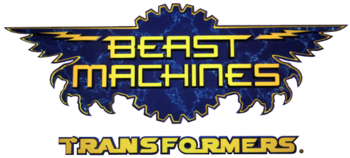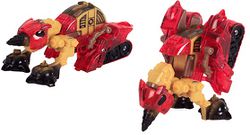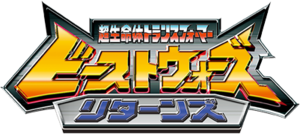Beast Machines: Transformers (toyline)
From Transformers Wiki
| ||||||||||||||||
Beast Machines was the toyline successor to Beast Wars, running from very late 1999 to early 2001. It featured the Maximals as smoothly techno-organic beasts, pitted against the futuristic war machines of the Vehicons. Beast Machines signaled the full-fledged return of vehicular Transformers, after an absence of nearly four years.
Though Beast Machines was the primary series in 2000, Hasbro continued to release Beast Wars case assortments, whose contents ranged from new redecos to promote Fox Kids running the series, to the new-mold Mutant Beast Wars figures, to straight-up re-releases of Transmetal 2 toys.
The line seemed to underperform to expectations, and combined with Hasbro's financial troubles (primarily due to excessive Star Wars Episode I product glut), the second year of Beast Machines product was cut short to make way for another heavy reworking of the Transformers concept...
Unlike Beast Wars, the line did not run concurrently in Japan, but would get a short run there in 2004.
Contents |
Overview
Beast Machines continued many of its predecessor's elements, retaining the Maximal faction and a number of its main characters, but now pitted against the new Vehicon faction. Both sides tended toward unorthodox designs; the toys also made frequent use of translucent plastic and chrome finishes. A concerted push was made towards giving the figures more character-centric internal action features as opposed to the missile launchers or simpler spring-loaded weaponry that defined Beast Wars, going so far as moving eyes or jaws. Spark crystals carried over from Beast Wars, eventually becoming central to the final gimmick in the line. Aesthetically, the smooth, curvaceous designs of the Maximals is a further evolution of the earlier Transmetal design styles, seamlessly blending the mechanical and the organic, often hiding mechanical detailing behind transparent panels. In contrast, the Vehicons had emphatically Cybertronian vehicle forms with visible machinery, often with certain character flourishes in vehicle mode like swiveling cockpits or a moving eye inside a tank turret. Both factions featured some unorthodox robot modes, with the Vehicons erring on the side of inhuman faces, weaponized limbs, and unusual forms of locomotion, while the Maximals tended towards more conventional yet exaggerated humanoid proportions.
Show-accuracy (including inter-character scale) was widely variable across the entire toy line. Show production house Mainframe Entertainment apparently began animating the characters from early concept sketches, designs that by necessity changed a great deal during the translation into toy form. Thus many characters' (initial) toy and cartoon depictions bear relatively little resemblance to each other.
The back end of the Beast Machines toyline, starting in 2001, featured the first full-on subline imprint for Transformers, called "Battle for the Spark", reflecting the storyline of the cartoon's second season. This also tied in with a unifying theme for the new-mold toys, where action features are activated by pressing on the spark crystals. By this time, many toys were designed to emulate their show models, and did so to an impressive degree. The more complex action features also led to the first price hike since the Transformers toyline had switched to standardized price classes at the start of Beast Wars, with the Basics class increasing from US$4.99 MSRP to $6.99.
The final releases of Beast Wars overlapped on the shelves with the start of Beast Machines, which was taken into account as some events from Beast Machines are directly referenced on the packaging of the Mutants. The Dinobots subline, consisting of redecoed molds from both the Hasbro Beast Wars and Takara Beast Wars Neo lines, shipped in the same packaging assortments with the normal figures.
Due to underwhelming sales, usual toyline fatigue, a particularly dark story, and internal Hasbro/Kenner shakeups,[1] it was decided to cancel the last few waves in development, abandon plans for the sequel series Transtech, and re-vamp the franchise from the ground up. Takara's Car Robots series was quickly ported over as "filler" under the name Robots in Disguise, giving Hasbro and Takara the time needed to coordinate on the next series. Not ones to waste the effort or cost put into the canceled figures, all three finished-yet-unreleased toy molds were eventually released as part of the Robots in Disguise toyline.
Hasbro Beast Machines toyline
Standard retail line
Basics
| Wave 1 (December 1999) | Wave 2 (March 2000) | Wave 3 (June 2000) | Wave 4 (August 2000) | |||||
| Wave 5 (BftS, January 2001) | Wave 6 (BftS, April 2001) | Wave 7 (BftS, April 2001) | Canceled |
Deluxe
- In addition to regular Beast Machines toys, the Deluxe assortment also included Dinobots-branded product.
| Wave 1 (December 1999) | Wave 2 (March 2000) | Wave 3 (March 2000) | Wave 4 (April 2000) | |||||
| Wave 5 (June 2000) | Wave 6 (September 2000) | Wave 7 (October 2000) | Wave 8 (BftS, February 2001) | |||||
| Wave 9 (BftS, March 2001) | Canceled (used later) | Totally canceled |
Mega
| Wave 1 (December 1999) | Wave 2 (August 2000) | Wave 3 (February 2001) | Wave 4 (BftS, May 2001) |
Ultra
- Like the Deluxes, the Ultra assortment also included Dinobots-branded stuff.
| Wave 1 (July 2000) | Wave 2 (September 2000) | Canceled |
Super
- Wave 1 (July 2000)
- A new price point for the line, the Supreme class featured the biggest/tallest Transformers toys since 1987's Fortress Maximus (if not the most massive).
- Air Attack Optimus Primal
- A Basic price point, the Deployers are small robo-beasts to turn into weapon emplacements with spring-loaded transformations. The Wave 2 running change redecoes were originally meant to be renamed as new characters: these names were revealed through retail listings[2] as "Trench," "Burro," and "Cro", with the latter eventually being repurposed as a new character.
- An unusual addition to the line, Beast Riders are combat chariots that can carry Basic-class figures, and convert into an attack mode. Like the Deployers, the Beast Riders got new decos for a second (pegwarming) round.
- McDonald's ran a Beast Machines promotion in August 2000. It came in two different cardboard "Happy Meal" boxes (which were co-branded with Hello Kitty)
- In 2001, four of the McDonald's molds were retooled to be simpler (which is hard to imagine but there you go) and redecoed by the Australian chain Red Rooster for their "Little Red Rooster" meals. Each one came in four different colorations: red & green, blue & light blue, and color-swaps of those two.
-
- Nightscream (actually the Megatron mold)
- In 2009, Philippine fast food chain Jollibee sold three Beast Machines figures as part of their "Jollibee Kids Meals", each one based on their original mainline toys. That was kind of weird.
- BR-01 Convoy
- BR-02 Cheetus
- BR-03 Rattle
- BR-04 Blackwidow
- BR-05 Megatron
- BR-06 Vehicon Tankor
- BR-07 Vehicon Jetstorm
- BR-08 Vehicon Thrust
- BR-09 Nightscream
- BR-10 Silverbolt
- BR-11 Noble Savage
- BR-12 Megahead Megatron
- BR-13 Vehicon Strika
- BR-14 Vehicon Obsidian
- Cheetus Black Version (Perfect Choice exclusive)
- The Deployers and Beast Riders were developed by (now-defunct) Hasbro Direct, Hasbro's department normally devoted to store exclusives and other retailer-oriented projects, hence their rather dubious compatibility with the rest of the Beast Machines line.
- A practice at the time of Beast Machines was to often have one concept artist design the robot mode and another design the beast/vehicle mode, leading to two forms that are startlingly different from each other... and probably leading to some hellish nightmares for the engineering department.
- On Takara's end of the design process, some design and engineering work was subcontracted out to the designer Junichi Akutsu, alias BEE-CRAFT.
- Early concepts for the Battle for the Spark continuation pitched the idea of interchangeable "Spark" accessories, one proposed version being a gearbox that drove complex gimmickry, while another functioned more like a Mini-Con or Cyber Key that unlocked spring-loaded features.[3]
- Around December 2000, the online retailer BigBadToyStore put up a list of upcoming Transformers product from Hasbro. Although the main point of interest was a Transtech assortment listing, it revealed several tail-end and unreleased Beast Machines: Battle for the Spark toys.
- French: Ani Machines (France), Mécanimaux (Canada)
- Spanish: Mecanibestias (Latin America)
- ↑ "For a long time, it had been sequential, so there was Beast Wars, and then Beast Machines came along—that wasn't performing as well, it was a little more... odd vehicle forms, or even beast forms. Beast Wars was great, you could tell what things were, even when they were hybrid or Fuzors, you could kind of tell what they were. If you look at Beast Machines, it's kind of like 'a truck thing' or 'a flying thing' or- so that alienated a certain amount of audience, so sales were going down. It got a little dark in the storyline at that same time. They were developing Transtech, but that was very short-lived. [...] That would have been the successor but because it was going down this dark road of Beast Machines and that wasn't working, obviously the sequel to that wasn't going to happen."—Aaron Archer on The Toy Armada, 2021/12/14
- ↑ http://web.archive.org/web/20001206140100/http://www.bigbadtoystore.com/news.asp
- ↑ Transformers Beast Wars: Beast Generations, p117
Supreme
| Wave 1 (July 2000) | Canceled (used later)
|
Deployers
| Wave 1 (August 2000) | Wave 2 (redecos, January 2001) |
Beast Riders
| Wave 1 (August 2000) | Wave 2 (redecoes, December 2000) |
Exclusives
| Target (October 2000) | BotCon 2000 (July 28, 2000) |
Fast food promotions
McDonald's
| The line-up: |
Red Rooster
Jollibee
Takara Beast Wars Returns toyline
| ||||||||||||||||
In Japan, Beast Machines did not see release until 2004 (the only figure to make it to Japan during the series' lifespan was Primal Prime). The entire line was Toys"R"Us-exclusive, and limited to about 3,000-4,000 units apiece. As such, some of these items command high prices on the secondary market, especially tail-end items.
The toys have been redecoed to (theoretically) better match the show models, some more extensively than others.
| Wave 1 (11-18-2004)
|
Wave 2 (3-31-2005)
|
Wave 3 (4-14-2005)
|
Lucky draw
|
Post-Beast Machines releases
Even after the original Beast Machines toyline ended, several cast members saw new toys released in other Transformers lines.


















